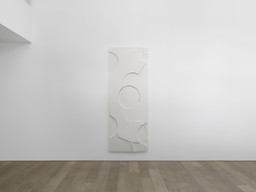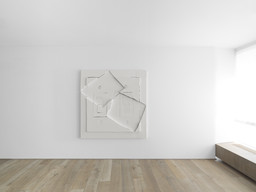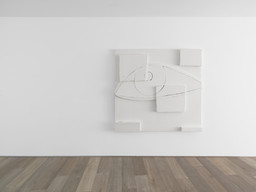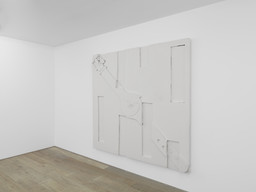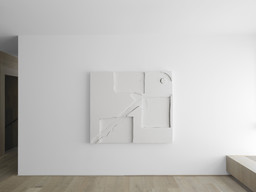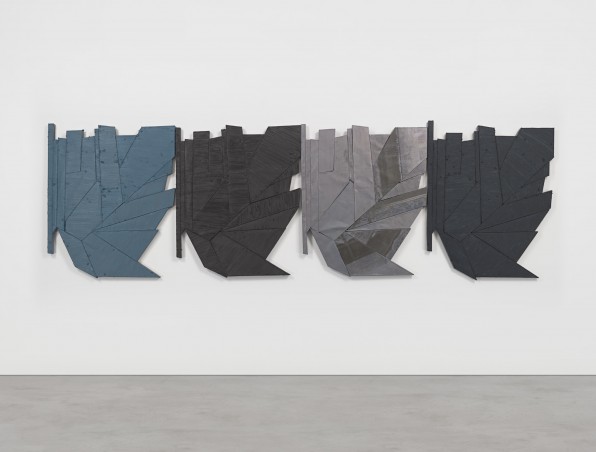Wyatt Kahn
23 January—27 February 2016
107 rue St-Georges | St-Jorisstraat
| 1 | / | 13 |
×
Xavier Hufkens is pleased to announce a new exhibition by American artist Wyatt Kahn.
Wyatt Kahn is known for a striking body of work that investigates the boundaries between painting, sculpture and drawing. Comprised of unprimed layers of linen stretched across wooden frames, Kahn assembles complex wall-mounted works in which the gaps between the individual panels form abstract or pictorial compositions. An initial way of approaching his oeuvre is to consider the way in which it is created: each new series typically begins with sketches in pencil and pen, which are slowly refined into definitive drawings. These are transferred onto wood and cut apart. Kahn then stretches two layers of linen or canvas over the panels, typically the same heavyweight material that would be used for stretching paintings.
While Kahn’s constructions might resemble paintings, and are made of similar materials, they are completely devoid of paint. Rather, they are three-dimensional, semi-sculptural objects in which negative space (the gaps between the panels) not only establishes structure and depth, but also line. In this sense, the works are akin to spatial drawings or, in other words, they are the three-dimensional iterations of two-dimensional, linear compositions. Dispensing with the arbitrary constraint of the rectangle, Kahn allows the formations to extend across the wall-space, sometimes leaving voids that capture the architectural support within the piece. Speaking of this facet of his work, Kahn has said: ‘I see them as drawings, where the wall is the paper. The whole object is the drawing on the wall.’
The artist’s oeuvre, which deals with both abstraction and representation, is based upon the history of the two central pillars of 20th-century American art: one being abstract and minimal painting and sculpture, the other being the use of imagery to express language, communication and humour. While previous series have explored one or other of these avenues individually, the artist’s most recent reliefs are an attempt to explore both simultaneously. At the same time, they can also be read as the materialization of far-reaching conceptual concerns – most notably the interdisciplinary tension that exists between sculpture, painting and drawing, as well as the dialogue between the ideas and ideologies surrounding the three traditional modes of artistic expression. Kahn is also interested in the idea of an undefined abstract space: an idea that he feels has emerged through the tension of architectural and pictorial space, and the emergence of a new form of space created in the advent of digital technology. Kahn has responded to this by creating reliefs that are possessed of a specific physicality, one that addresses the more recognisable space of the object, but also the new space of the abstraction. The objects depicted in this series are representative of the artist’s on-going exploration of certain subjects, such as figuration, and are recognisable from previous bodies of work. By consistently honing in on these concerns, the artist is developing a language that runs throughout, and connects, his entire oeuvre.
Kahn’s compositions are also on a human scale, both as a way of augmenting the viewer’s physical relationship to the object, and also of the artist to his work: nothing exceeds the limits of what can be created by the human hand. Thus the idea of craftsmanship, and the flaws inherent within hand-production, comes to the fore. Of this Kahn has said: ‘making a perfect work is not interesting to me, but human error is. You look for those moments, and when you find one it makes it all worth it. It adds another layer.’ It is this sense of ‘natural failure’ – the impossibility of achieving perfection within the handcrafted – which sets Kahn’s contemporary interpretation of minimalism apart from that of the 1960s and 1970s, which was predicated upon perfectionism. Kahn’s enigmatic and multilayered constructions repay careful contemplation – the more one looks, the more one sees. In the end, the conceptual and formal ambiguities inherent within the pieces, and their subtle surface imperfections, give way to a thought-provoking sense of unity.
Wyatt Kahn (b. 1983) lives and works in New York. Recent solo exhibitions include: Work, Performa 15 Biennial, Swedish Cottage Marionette Theatre, New York (2015); Wyatt Kahn: Object Paintings, Contemporary Art Museum, St. Louis, USA (2015) and Wyatt Kahn, LA><ART, Los Angeles (2014). Group shows include: Space Between, Curated by Louis Grachos and Stephanie Roach, FLAG Art Foundation, New York (2015); Abstract America Today, Saatchi Gallery, London (2014) and Never Enough: Recent Acquisitions of Contemporary Art, Dallas Museum of Art (2014).



